Multi-Objective Optimization of Bifacial Photovoltaic Sunshade: Towards Better Optical, Electrical and Economical Performance
Abstract
:1. Introduction
2. Methodology
2.1. Multi-Objective Optimization (MOO)
2.2. BiPVS MOO Framework
- (1)
- The objective of better daylighting (UDI500–2000)
- (2)
- The objective of less building energy consumption (EC)
- (3)
- The objective of a shorter payback period (PB)
- PB is the static payback period, y;
- S is the total installed area of the vertical bifacial PV sunshade modules, m2;
- Q is the total annual power generation of the vertical double-sided PV sunshade system, kWh;
- Ci is the cost of PV modules per unit area, CNY/m2;
- Cr is the cost of PV system accessory facilities per unit area, CNY/m2;
- T is the electricity price of power grid, CNY/kWh.
3. Case Study
4. Optimization Result
5. Discussion and Limitation
6. Conclusions
Author Contributions
Funding
Institutional Review Board Statement
Informed Consent Statement
Data Availability Statement
Conflicts of Interest
Abbreviations
| BiPVS | Bifacial photovoltaic sunshade |
| MOO | Multi-objective optimization |
| UDI500–2000 | Hours of useful daylight illuminance (hour) |
| EC | Annual building energy consumption for air-conditioning (kWh/m2) |
| PB | Payback period of the BiPVS (year) |
References
- China Association of Building Energy Efficiency. China Building Energy Research Report 2020 (In Chinese). Available online: https://www.cabee.org/site/content/24021.html (accessed on 30 May 2024).
- Duan, H.; Chen, S.; Song, J. Characterizing regional building energy consumption under joint climatic and socioeconomic impacts. Energy 2022, 245, 123290. [Google Scholar] [CrossRef]
- Shi, S.; Zhu, N. Challenges and Optimization of Building-Integrated Photovoltaics (BIPV) Windows: A Review. Sustainability 2023, 15, 15876. [Google Scholar] [CrossRef]
- Zheng, Y.; Li, X.; Zhang, W.; Wang, K.; Han, F.; Li, X.; Zhao, Y. Experimental study of phase change microcapsule suspensions applied in BIPV construction. Sustainability 2022, 14, 10819. [Google Scholar] [CrossRef]
- Dong, Y.; Duan, H.; Li, X.; Zhang, R. Influence of Different Forms on BIPV Gymnasium Carbon-Saving Potential Based on Energy Consumption and Solar Energy in Multi-Climate Zones. Sustainability 2024, 16, 1656. [Google Scholar] [CrossRef]
- Baumann, T.; Nussbaumer, H.; Klenk, M.; Dreisiebner, A.; Carigiet, F.; Baumgartner, F. Photovoltaic systems with vertically mounted bifacial PV modules in combination with green roofs. Sol. Energy 2019, 190, 139–146. [Google Scholar] [CrossRef]
- Soria, B.; Gerritsen, E.; Lefillastre, P.; Broquin, J. A study of the annual performance of bifacial photovoltaic modules in the case of vertical facade integration. Energy Sci. Eng. 2015, 4, 52–68. [Google Scholar] [CrossRef]
- Chen, M.; Zhang, W.; Xie, L.; He, B.; Wang, W.; Li, J.; Li, Z. Improvement of the electricity performance of bifacial PV module applied on the building envelope. Energy Build. 2021, 238, 110849. [Google Scholar] [CrossRef]
- Li, Z.; Zhang, W.; He, B.; Xie, L.; Chen, M.; Li, J.; Zhao, O.; Wu, X. A comprehensive life cycle assessment study of innovative bifacial photovoltaic applied on building. Energy 2022, 245, 123212. [Google Scholar] [CrossRef]
- Kopecek, R.; Libal, J. Towards large-scale deployment of bifacial photovoltaics. Nat. Energy 2018, 3, 443–446. [Google Scholar] [CrossRef]
- Ko, M.; Lee, G.; Kim, C.; Lee, Y.; Ko, J.; Song, H.J. Dielectric/metal/dielectric selective reflector for improved energy efficiency of building integrated bifacial c-Si photovoltaic modules. Curr. Appl. Phys. 2021, 21, 101–106. [Google Scholar] [CrossRef]
- Assoa, Y.B.; Thony, P.; Messaoudi, P.; Schmitt, E.; Bizzini, O.; Gelibert, S.; Therme, D.; Rudy, J.; Chabuel, F. Study of a building integrated bifacial photovoltaic facade. Sol. Energy 2021, 227, 497–515. [Google Scholar] [CrossRef]
- Tina, G.M.; Scavo, F.B.; Aneli, S.; Gagliano, A. Assessment of the electrical and thermal performances of building integrated bifacial photovoltaic modules. J. Clean. Prod. 2021, 313, 127906. [Google Scholar] [CrossRef]
- Raina, G.; Sinha, S. A comprehensive assessment of electrical performance and mismatch losses in bifacial PV module under different front and rear side shading scenarios. Energy Convers. Manag. 2022, 261, 115668. [Google Scholar] [CrossRef]
- Pelaez, S.A.; Deline, C.; MacAlpine, S.M.; Marion, B.; Stein, J.S.; Kostuk, R.K. Comparison of bifacial solar irradiance model predictions with field validation. IEEE J. Photovolt. 2018, 9, 82–88. [Google Scholar] [CrossRef]
- Li, C.; Zhang, W.; Tan, J.; Liu, W.; Lyu, Y.; Tang, H. Energy performance of an innovative bifacial photovoltaic sunshade (BiPVS) under hot summer and warm winter climate. Heliyon 2023, 9, e18700. [Google Scholar] [CrossRef]
- Khoroshiltseva, M.; Slanzi, D.; Poli, I. A Pareto-based multi-objective optimization algorithm to design energy-efficient shading devices. Appl. Energy 2016, 184, 1400–1410. [Google Scholar] [CrossRef]
- Bamdad, K.; Mohammadzadeh, N.; Cholette, M.; Perera, S. Model Predictive Control for Energy Optimization of HVAC Systems Using EnergyPlus and ACO Algorithm. Buildings 2023, 13, 3084. [Google Scholar] [CrossRef]
- Makki, M.; Navarro-Mateu, D.; Showkatbakhsh, M. Decoding the Architectural Genome: Multi-Objective Evolutionary Algorithms in Design. Technol. Archit. Des. 2022, 6, 68–79. [Google Scholar] [CrossRef]
- Samarasinghalage, T.I.; Wijeratne, W.P.U.; Yang, R.J.; Wakefield, R. A multi-objective optimization framework for building-integrated PV envelope design balancing energy and cost. J. Clean. Prod. 2022, 342, 130930. [Google Scholar] [CrossRef]
- Yi, Y.K.; Tariq, A.; Park, J.; Barakat, D. Multi-objective optimization (MOO) of a skylight roof system for structure integrity, daylight, and material cost. J. Build. Eng. 2021, 34, 102056. [Google Scholar] [CrossRef]
- Fan, Z.; Liu, M.; Tang, S. A multi-objective optimization design method for gymnasium facade shading ratio integrating energy load and daylight comfort. Build. Environ. 2022, 207, 108527. [Google Scholar] [CrossRef]
- Rajani; Prakash, A. A Comparison of MOEA/D, NSGA II and SPEA2 Algorithms. Int. J. Eng. Trends Appl. (IJETA) 2017, 4, 58. [Google Scholar]
- Vachhani, V.L.; Dabhi, V.K.; Prajapati, H.B. Survey of multi objective evolutionary algorithms. In Proceedings of the 2015 International Conference on Circuits, Power and Computing Technologies [ICCPCT-2015], Nagercoil, India, 19–20 March 2015; IEEE: Piscataway, NJ, USA, 2015; pp. 1–9. [Google Scholar]
- Ekici, B.; Cubukcuoglu, C.; Turrin, M.; Sariyildiz, I.S. Performative computational architecture using swarm and evolutionary optimisation: A review. Build. Environ. 2019, 147, 356–371. [Google Scholar] [CrossRef]
- Shukla, P.K.; Deb, K.; Tiwari, S. Comparing classical generating methods with an evolutionary multi-objective optimization method. In International Conference on Evolutionary Multi-Criterion Optimization; Springer: Berlin/Heidelberg, Germany, 2005; pp. 311–325. [Google Scholar]
- Wang, S.S.; Yi, Y.K.; Liu, N.X. Multi-objective optimization (MOO) for high-rise residential buildings’ layout centered on daylight, visual, and outdoor thermal metrics in China. Build. Environ. 2021, 205, 108263. [Google Scholar] [CrossRef]
- Kim, H.; Clayton, M.J. A multi-objective optimization approach for climate-adaptive building envelope design using parametric behavior maps. Build. Environ. 2020, 185, 107292. [Google Scholar] [CrossRef]
- Giouri, E.D.; Tenpierik, M.; Turrin, M. Zero energy potential of a high-rise office building in a Mediterranean climate: Using multi-objective optimization to understand the impact of design decisions towards zero-energy high-rise buildings. Energy Build. 2020, 209, 109666. [Google Scholar] [CrossRef]
- Taveres-Cachat, E.; Lobaccaro, G.; Goia, F.; Chaudhary, G. A methodology to improve the performance of PV integrated shading devices using multi-objective optimization. Appl. Energy 2019, 247, 731–744. [Google Scholar] [CrossRef]
- Wu, H.; Deng, F.; Tan, H. Research on parametric design method of solar photovoltaic utilization potential of nearly zero-energy high-rise residential building based on genetic algorithm. J. Clean. Prod. 2022, 368, 133169. [Google Scholar] [CrossRef]
- Makki, M.; Showkatbakhsh, M.; Song, Y. ‘Wallacei Primer 2.0’, [EB/OL]. 2019. Available online: https://www.wallacei.com/ (accessed on 30 May 2024).
- Deb, K.; Pratap, A.; Agarwal, S.; Meyarivan, T. A fast and elitist multiobjective genetic algorithm: NSGA-II. IEEE Trans. Evol. Comput. 2002, 6, 182–197. [Google Scholar] [CrossRef]
- Nabil, A.; Mardaljevic, J. Useful daylight illuminances: A replacement for daylight factors. Energy Build. 2006, 38, 905–913. [Google Scholar] [CrossRef]
- Li, K.; Deb, K.; Zhang, Q.; Kwong, S. An Evolutionary Many-Objective Optimization Algorithm Based on Dominance and Decomposition. IEEE Trans. Evol. Comput. 2015, 19, 694–716. [Google Scholar] [CrossRef]
- GB50033-2013; Ministry of Housing and Urban-Rural Development of the People’s Republic of China. Standard for Daylighting Design of Buildings. China Architecture & Building Press: Beijing, China, 2013.
- GB/T50378-2019; Ministry of Housing and Urban-Rural Development of the People’s Republic of China. Assessment Standard for Green Building. China Architecture & Building Press: Beijing, China, 2019.
- Ladybug Plug-in Homepage. Available online: https://www.ladybug.tools (accessed on 30 May 2024).
- Radiance Software Homepage. Available online: https://www.radiance-online.org/ (accessed on 30 May 2024).
- Honeybeeplug-in Homepage. Available online: https://www.ladybug.tools/honeybee.html (accessed on 30 May 2024).
- Energyplus Software Homepage. Available online: https://energyplus.net (accessed on 30 May 2024).
- Hoseinzadeh, P.; Assadi, M.K.; Heidari, S.; Khalatbari, M.; Saidur, R.; Nejad, K.H.; Sangin, H. Energy performance of building integrated photovoltaic high-rise building: Case study, Tehran, Iran. Energy Build. 2021, 235, 110707. [Google Scholar] [CrossRef]
- Motamedi, S.; Liedl, P. Integrative algorithm to optimize skylights considering fully impacts of daylight on energy. Energy Build. 2017, 138, 655–665. [Google Scholar] [CrossRef]
- Li, C.; Tan, J.; Chow, T.-T.; Qiu, Z. Experimental and theoretical study on the effect of window films on building energy consumption. Energy Build. 2015, 102, 129–138. [Google Scholar] [CrossRef]
- Aguilar-Carrasco, M.T.; Díaz-Borrego, J.; Acosta, I.; Campano, M.; Domínguez-Amarillo, S. Validation of lighting parametric workflow tools of Ladybug and Solemma using CIE test cases. J. Build. Eng. 2023, 64, 105608. [Google Scholar] [CrossRef]
- Kharvari, F. An empirical validation of daylighting tools: Assessing radiance parameters and simulation settings in Ladybug and Honeybee against field measurements. Sol. Energy 2020, 207, 1021–1036. [Google Scholar] [CrossRef]
- Shafavi, N.S.; Tahsildoost, M.; Zomorodian, Z.S. Investigation of illuminance-based metrics in predicting occupants’ visual comfort (case study: Architecture design studios). Sol. Energy 2020, 197, 111–125. [Google Scholar] [CrossRef]
- Chen, X.; Qiu, Y.; Wang, X. A systematic review of research methods and economic feasibility of photovoltaic integrated shading device. Energy Build. 2024, 311, 114172. [Google Scholar] [CrossRef]
- Hong, T.; Koo, C.; Kwak, T.; Park, H.S. An economic and environmental assessment for selecting the optimum new renewable energy system for educational facility. Renew. Sustain. Energy Rev. 2014, 29, 286–300. [Google Scholar] [CrossRef]
- Ferroni, F.; Hopkirk, R.J. Energy Return on Energy Invested (ERoEI) for photovoltaic solar systems in regions of moderate insolation. Energy Policy 2016, 94, 336–344. [Google Scholar] [CrossRef]
- Orioli, A.; Di Gangi, A. The recent change in the Italian policies for photovoltaics: Effects on the payback period and levelized cost of electricity of grid-connected photovoltaic systems installed in urban contexts. Energy 2015, 93, 1989–2005. [Google Scholar] [CrossRef]
- GB55015-2021; Ministry of Housing and Urban-Rural Development of the People’s Republic of China. General Code for Energy Efficiency and Renewable Energy Application in Buildings. China Architecture & Building Press: Beijing, China, 2022.
- Available online: https://climate.onebuilding.org (accessed on 30 May 2024).
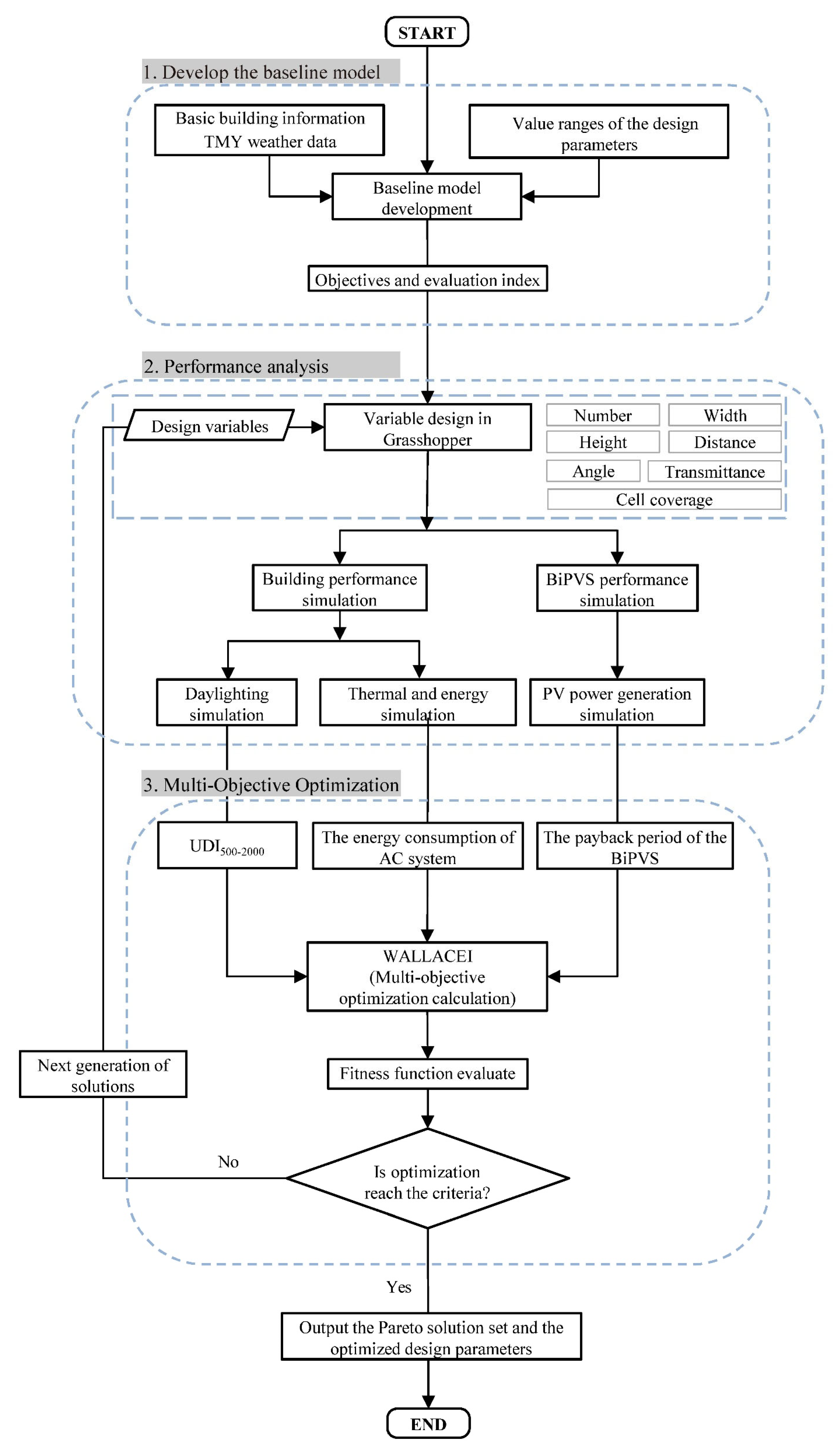

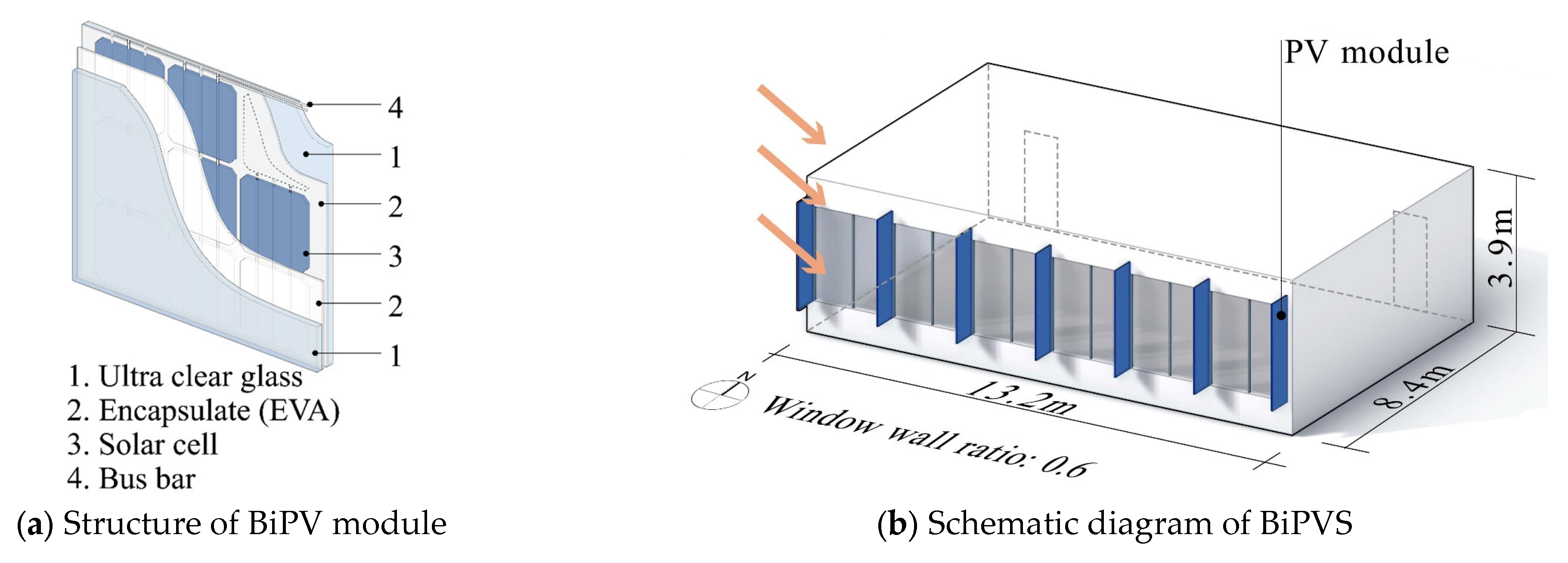
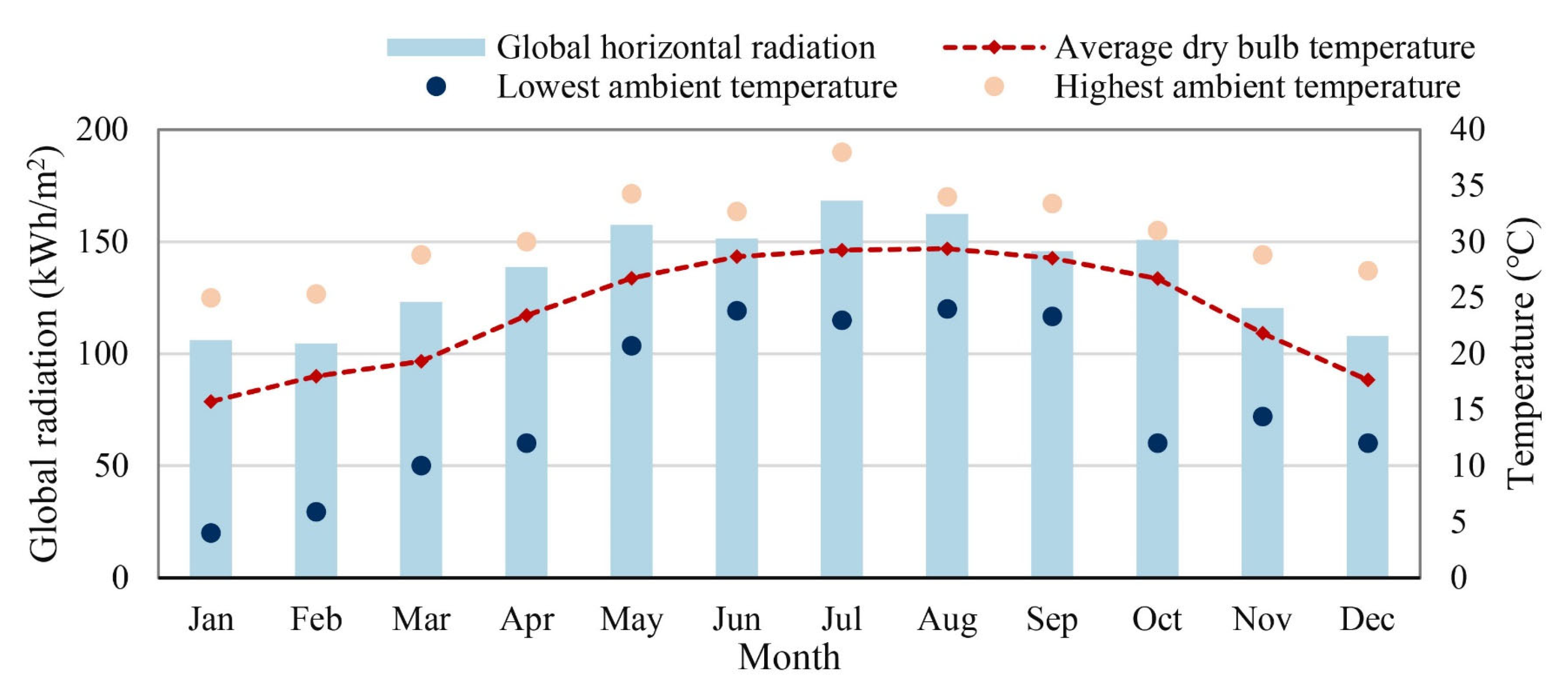


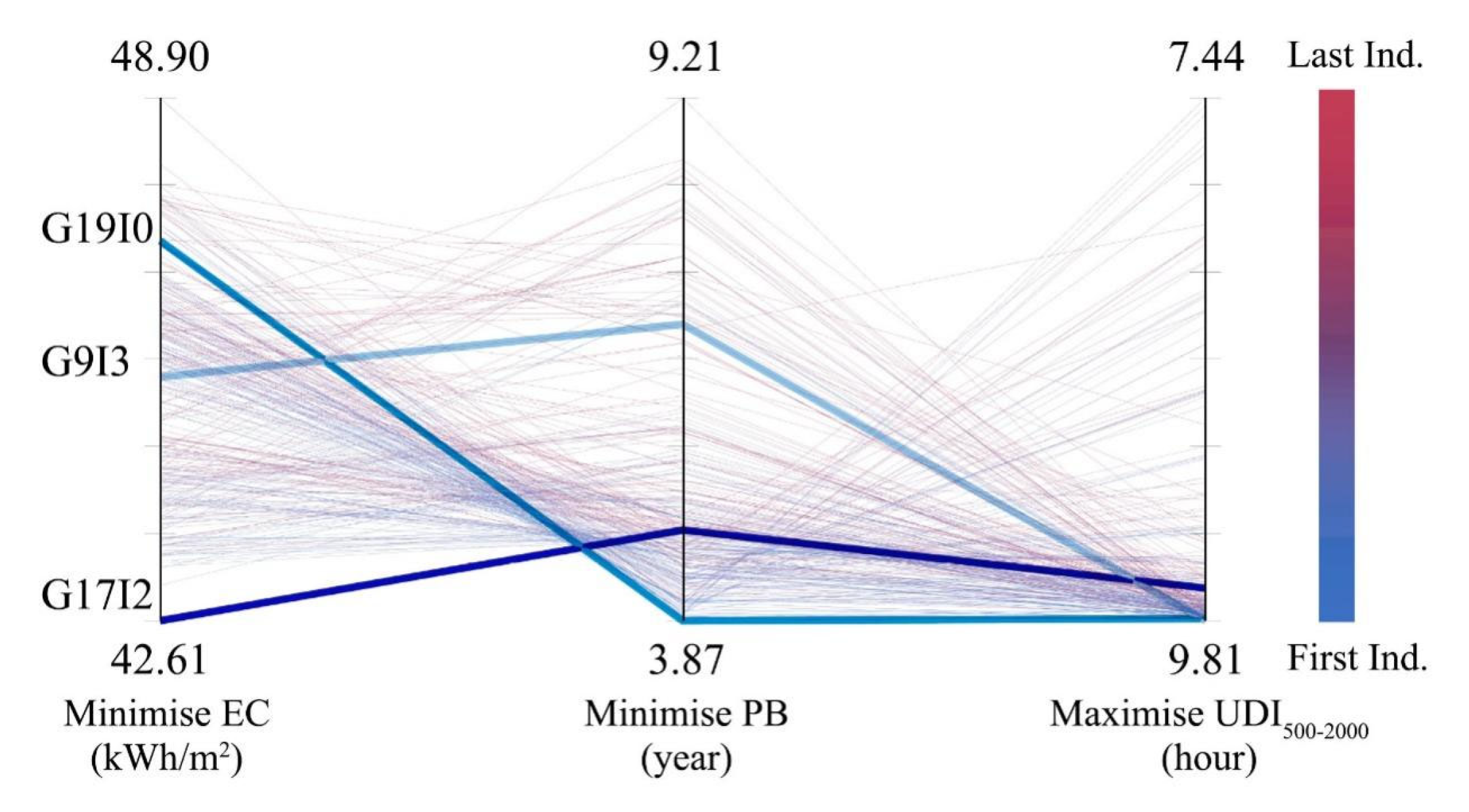

| Application Form | Schematic Diagram | Characteristics |
|---|---|---|
| Curtain window |  | The power generation ability of the rear side was not fully explored. |
| Roof and facade | 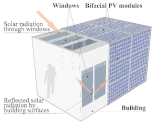 | The thermal insulation was reduced, and cooling load would increase. |
| Vertically mounted sunshade (BiPVS under investigation) |  | The incident solar radiation from both front and rear sides were fully explored, without compromising thermal insulation of the envelop. |
| Reference No. | Research Object | Multiple Objectives |
|---|---|---|
| [17] | Design energy-efficient shading devices |
|
| [20] | Building-integrated PV Envelope design |
|
| [21] | A skylight roof system |
|
| [22] | Gymnasium facade shading |
|
| [29] | Envelope design Facade photovoltaic-integrated surfaces The cooling setpoint |
|
| [28] | Climate-adaptive building envelope design in a hot and humid climate |
|
| [30] | PV integrated shading devices |
|
| [31] | A typical high-rise residential building |
|
| Parameter | Unit | Value |
|---|---|---|
| Window glazing transmittance | - | 0.89 |
| HVAC system | - | Ideal loads air |
| Internal load lighting | W/m2 | 8 |
| Internal load equipment | W/m2 | 15 |
| U-value window | W/(m2-K) | 2.5 |
| Solar heat gain coefficient | - | 0.35 |
| Design Parameter | Unit | Value Ranges |
|---|---|---|
| BiPVS module numbers | - | 2~17, with an interval of 1 |
| Width of the modules | m | 0.3~1.0, with an interval of 0.1 |
| Height of the modules | m | 2.4~3.0, with an interval of 0.1 |
| Distance of the modules edge from the wall | m | 0.0~0.3, with an interval of 0.1 |
| Angle between the front side of the modules and the wall | ° | 60~120, with an interval of 5 |
| PV cells coverage rate | % | 50~100, with an interval of 1 |
| Window glazing transmittance | - | 0.10~0.90, with an interval of 0.01 |
| Name | Value |
|---|---|
| Generation Size | 40 |
| Generation Count | 20 |
| Crossover Probability | 0.9 |
| Mutation Probability | 1/7 |
| Optimization Objectives | Unit | Solution G9I3 | Solution G17I2 | Solution G19I0 |
|---|---|---|---|---|
| UDI500–2000 | hour | 9.81 | 9.62 | 9.80 |
| Energy consumption of air conditioning system | kWh/m2 | 45.54 | 42.61 | 47.18 |
| Payback period | year | 6.90 | 4.80 | 3.87 |
| Annual PV power generation | kWh | 2562.74 | 8697.89 | 950.83 |
| Design Parameter | Unit | Value |
|---|---|---|
| Range of BiPVS module numbers | - | 17 |
| Width of the modules | m | 1 |
| Height of the modules | m | 3 |
| Distance of the modules edge from the wall | m | 0 |
| Angle between the front side of the modules and the wall | ° | 115 |
| PV cells coverage rate | % | 98 |
| Window glazing transmittance | - | 0.89 |
Disclaimer/Publisher’s Note: The statements, opinions and data contained in all publications are solely those of the individual author(s) and contributor(s) and not of MDPI and/or the editor(s). MDPI and/or the editor(s) disclaim responsibility for any injury to people or property resulting from any ideas, methods, instructions or products referred to in the content. |
© 2024 by the authors. Licensee MDPI, Basel, Switzerland. This article is an open access article distributed under the terms and conditions of the Creative Commons Attribution (CC BY) license (https://creativecommons.org/licenses/by/4.0/).
Share and Cite
Li, C.; Zhang, W.; Liu, F.; Li, X.; Wang, J.; Li, C. Multi-Objective Optimization of Bifacial Photovoltaic Sunshade: Towards Better Optical, Electrical and Economical Performance. Sustainability 2024, 16, 5977. https://doi.org/10.3390/su16145977
Li C, Zhang W, Liu F, Li X, Wang J, Li C. Multi-Objective Optimization of Bifacial Photovoltaic Sunshade: Towards Better Optical, Electrical and Economical Performance. Sustainability. 2024; 16(14):5977. https://doi.org/10.3390/su16145977
Chicago/Turabian StyleLi, Chunying, Wankun Zhang, Fang Liu, Xiaoyu Li, Jingwei Wang, and Cuimin Li. 2024. "Multi-Objective Optimization of Bifacial Photovoltaic Sunshade: Towards Better Optical, Electrical and Economical Performance" Sustainability 16, no. 14: 5977. https://doi.org/10.3390/su16145977





